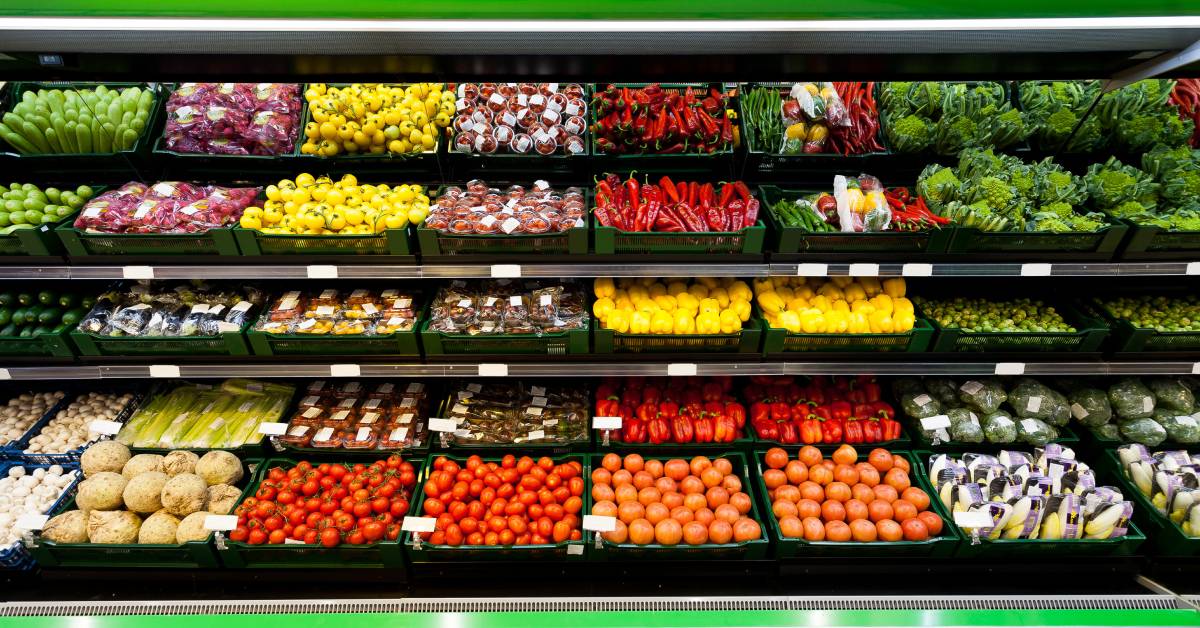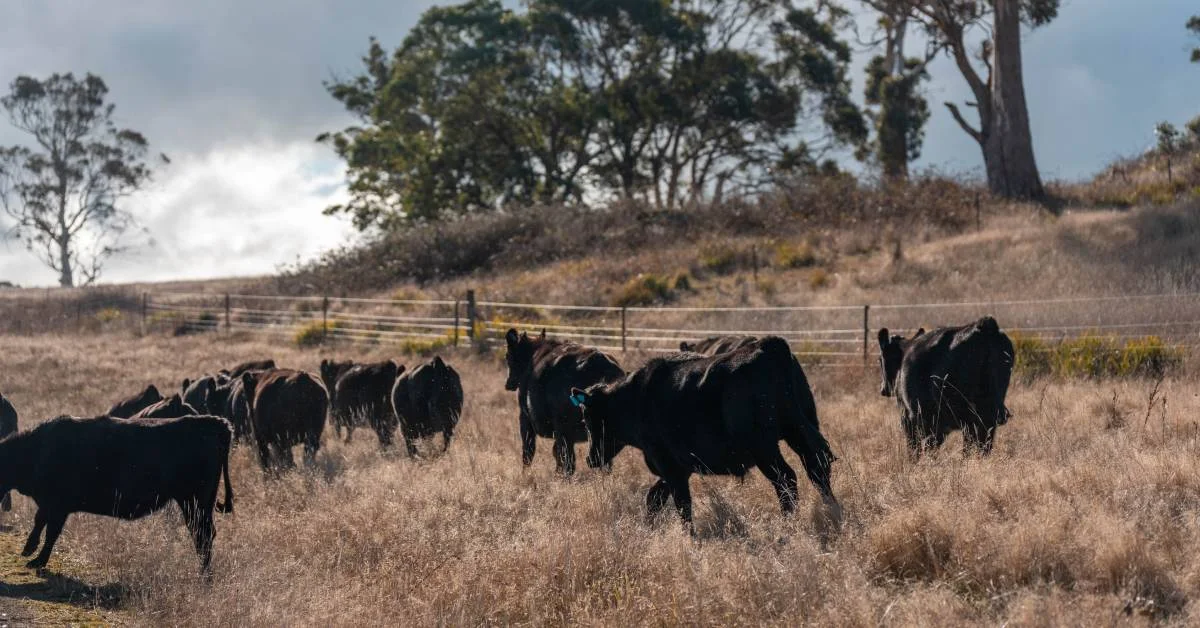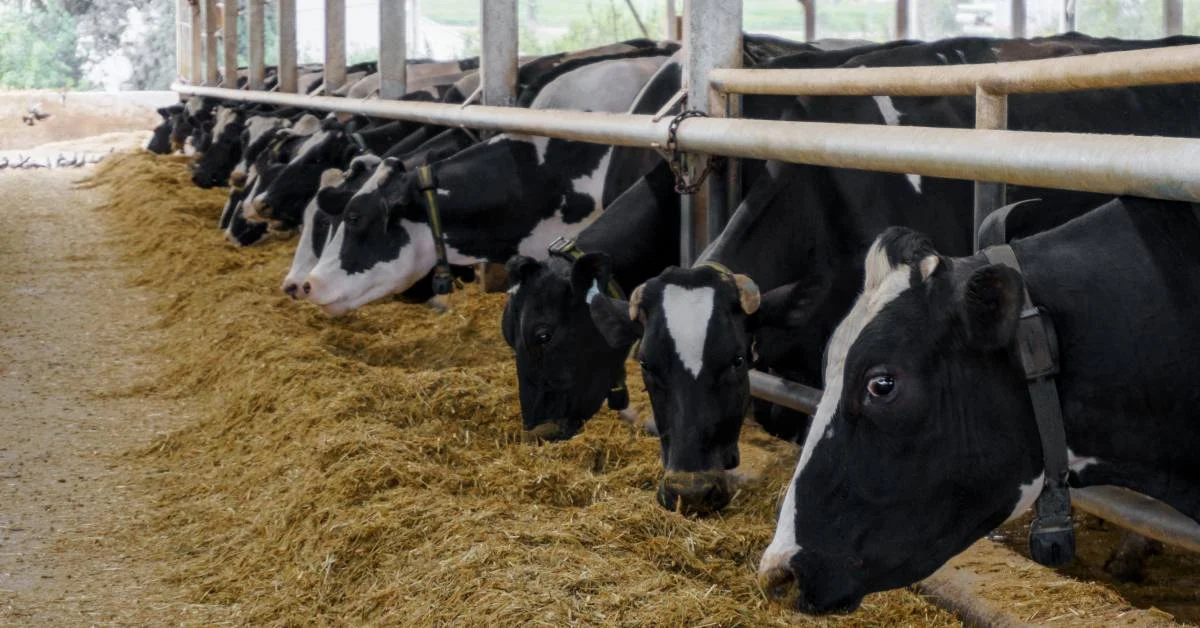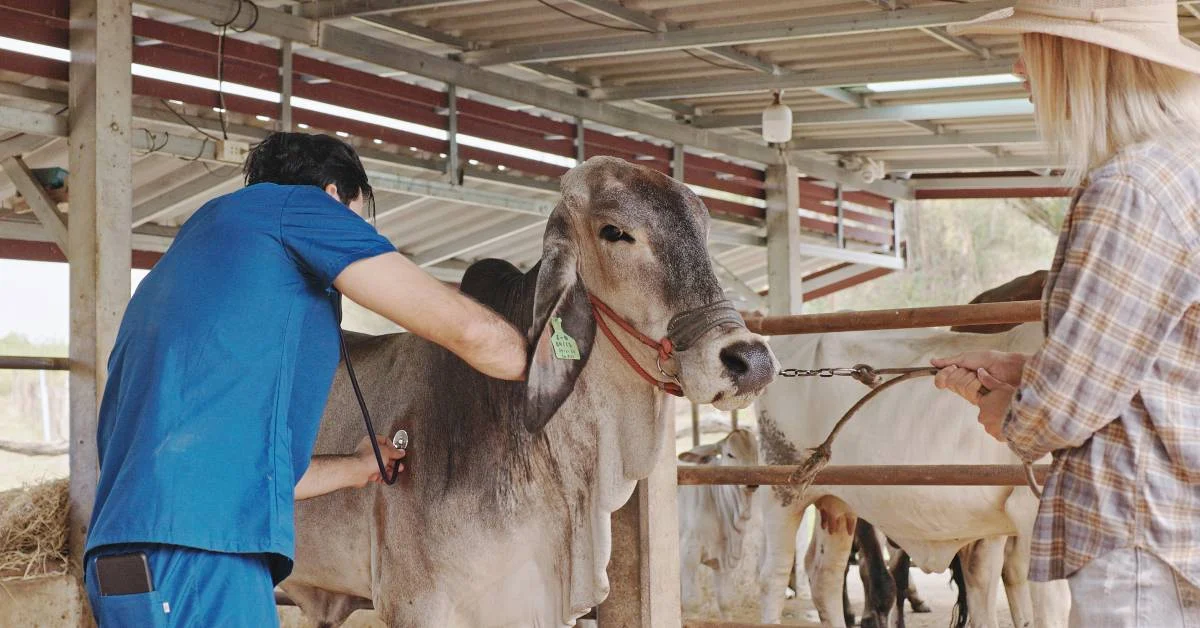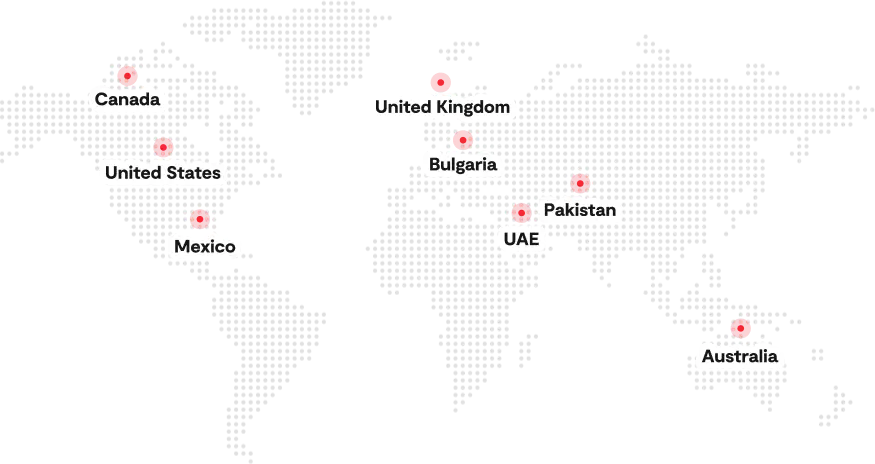Within the agricultural industry, fresh produce quality control plays a vital role in ensuring that fruits and vegetables reach consumers in their best condition: fresh, safe, and full of nutritional value. It involves systematic monitoring, inspection, and handling practices designed to preserve quality from harvest to retail shelves. Without proper produce quality control, even the best crops can deteriorate quickly, leading to significant economic and food losses.
According to recent data, about 13.3 percent of food is lost globally after harvest during on-farm handling, transport, storage, and processing. These losses often stem from poor temperature regulation, inefficient packaging, or delays across the supply chain, making quality control essential to minimize waste and protect profitability. As export and retail standards continue to rise, fresh produce quality control has become even more crucial.
In this blog, we’ll explore the key practices, technologies, and systems that help maintain produce quality, extend shelf life, and build consumer trust in an increasingly competitive global market.
Understanding Produce Quality and Its Key Indicators
Produce quality is the measure of a fruit or vegetable’s overall condition, reflecting its appearance, texture, flavor, and nutritional value. It determines how appealing the product is to consumers and how well it meets market and export standards. High-quality produce is visually attractive, tastes fresh, and retains its nutrients through proper harvesting and handling.
In the context of produce quality control, both external and internal parameters play a critical role. External indicators include:
- Color
- Size
- Shape
- Firmness
Internal quality parameters focus on measurable attributes such as:
- Sugar content (Brix level)
- Moisture
- Acidity
- Bioactive compounds
These factors define the product’s true nutritional profile. Maintaining consistency across them is essential for any grower or distributor focused on superior produce quality.
To ensure these standards, sensory evaluations and laboratory-based testing are often integrated into modern produce quality control systems. Sensory testing involves trained panels assessing attributes like taste, aroma, and mouthfeel, while lab testing uses tools such as spectrometers, refractometers, and texture analyzers for accurate quality measurements. Together, these methods provide actionable data for producers to refine storage, packaging, and handling protocols.
By applying advanced testing and monitoring techniques throughout the fresh produce supply chain, farmers and distributors can detect quality issues early, reduce waste, and deliver products that meet consumer expectations and regulatory benchmarks. Ultimately, understanding and measuring produce quality at every stage ensures longer shelf life, higher customer satisfaction, and stronger market competitiveness.
Factors That Affect Fresh Produce Quality
Maintaining high produce quality requires more than just careful harvesting. Every stage after picking, from cooling to handling, transportation, and storage, plays a vital role in determining how fresh, nutritious, and safe the final product will be when it reaches consumers. Below are the main factors that influence how effectively produce quality control systems protect your harvest.
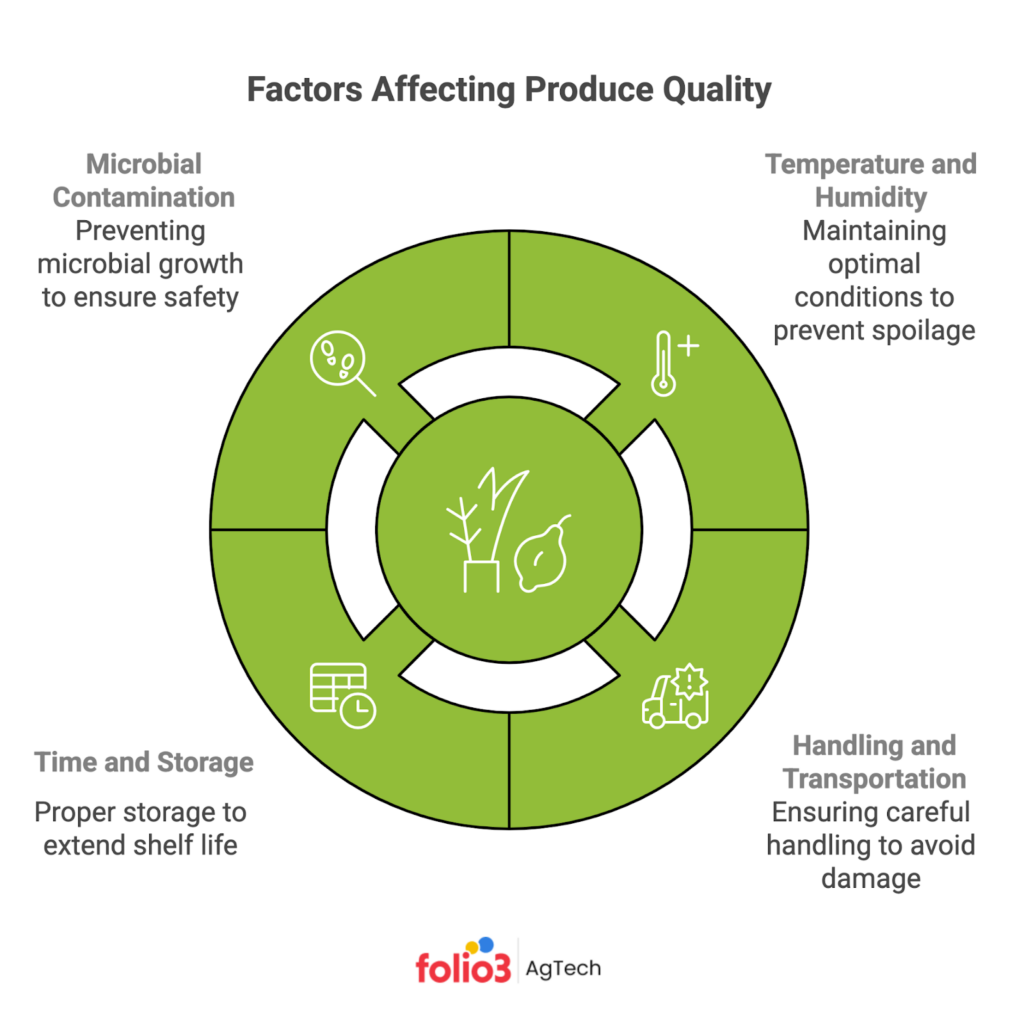
Temperature and Humidity Management
Temperature and humidity are the two most critical factors in fresh produce quality control. When produce is not cooled quickly after harvest, its respiration rate increases, leading to faster water loss, wilting, and nutrient degradation. Even a slight delay in cooling can trigger a chain reaction that affects both shelf life and appearance. For instance, leafy greens should be hydrocooled to ≤4 °C within 60–90 minutes after harvest to maintain freshness and visual quality.
For example, leafy greens stored just a few degrees above their optimal range can lose freshness within hours. In contrast, maintaining precise temperature and humidity, especially in greenhouse farming setups, helps stabilize produce respiration and preserve its natural texture and flavor.
Advanced controlled environment agriculture techniques, such as automated cooling systems and real-time humidity sensors, enable growers to maintain ideal post-harvest conditions and minimize spoilage across the supply chain.
Handling and Transportation
Poor handling practices can destroy the benefits of even the most effective produce quality control systems. Bruising, excessive vibration, or improper stacking during transport causes internal tissue damage, which accelerates decay and reduces market value.
Soft fruits like tomatoes and berries are especially vulnerable. To prevent these losses, growers must invest in cushioned packaging, climate-controlled transport, and regular training for workers who handle produce. When paired with digital monitoring tools, these measures ensure safer transit and maintain optimal produce quality from farm to shelf.
Time and Storage Conditions
Delays between harvesting and cooling are among the most common causes of post-harvest losses. The longer the gap, the greater the respiration and microbial activity. Efficient logistics, rapid pre-cooling, and temperature-controlled warehouses are vital for successful produce quality control. Implementing practices like FIFO (First In, First Out) or FEFO (First Expired, First Out), intelligent slotting logic, cross-docking for quick transfers, and dynamic routing for hot loads further minimize delays and maintain product integrity throughout the cold chain.
Incorporating smart tracking tools allows producers to monitor timing and conditions in real time, ensuring that each product maintains consistent freshness during distribution. This proactive approach supports both profitability and sustainable agriculture by minimizing waste and energy use.
Ethylene & Gas Management
Many fruits and vegetables are highly sensitive to ethylene, a natural ripening hormone that can accelerate spoilage when unmanaged. Effective fresh produce quality control involves using ethylene scrubbers, absorbers, and proper ventilation systems to regulate gas levels. Segregating climacteric produce (like bananas and tomatoes) from non-climacteric types (such as leafy greens or berries) helps prevent premature ripening and ensures longer shelf life during storage and transport.
Microbial Contamination
Microbial decay and biological contamination remain a major threat to fresh produce quality control. Bacteria, molds, and yeasts thrive in moist environments, especially when hygiene standards are ignored. Cleaning tools, sanitizing surfaces, and using treated water during washing are crucial steps to prevent contamination.
Regular sanitation audits and microbial testing enhance produce quality control by ensuring safety and compliance with food regulations. By integrating these practices, growers protect consumers while upholding brand integrity, ensuring every product reaches the market fresh, safe, and nutrient-rich.
Best Practices in Produce Quality Control
Maintaining the highest standards of produce quality control requires a combination of smart pre-harvest planning, careful post-harvest handling, and the right technologies to preserve freshness and safety. From the field to the final shelf, every step contributes to how consumers perceive and trust your brand. The following best practices outline how growers and distributors can strengthen fresh produce quality control throughout the supply chain.
Pre-Harvest Quality Management
Quality control begins long before harvesting. Healthy crops grown under the right soil, irrigation, and pest management conditions have a much better chance of maintaining their produce quality after harvest. Monitoring crop health through soil testing, pest control, and nutrient management ensures that plants develop strong cellular structures that resist bruising and decay.
Maturity indices, such as firmness, color, and sugar content, are equally important. Harvesting produce too early or too late can impact its shelf life and taste. Farmers must also monitor pesticide application schedules carefully to meet both food safety and export standards. Integrating precision agriculture tools during this stage helps align produce quality control goals with sustainable agriculture and compliance.
Post-Harvest Handling
Once produce is harvested, handling determines whether the product retains its freshness and visual appeal. Sorting and grading eliminate damaged or diseased produce before storage, ensuring consistent quality and market uniformity. Washing with clean, sanitized water removes soil, pesticide residue, and microbes, minimizing the risk of contamination.
In fresh produce quality control, consistency is key. Automated sorting systems with optical sensors can evaluate produce color and size with high accuracy, improving operational efficiency. The manufacturing of these machines often involves precision parts produced through CNC machining services, which ensure equipment reliability and performance. Clean workstations and trained staff further reduce post-harvest damage, ensuring that produce maintains its nutritional and sensory value.
Cold Chain Management
Temperature management is one of the most critical pillars of produce quality control. A well-managed cold chain management system prevents temperature fluctuations that can trigger spoilage, moisture loss, and microbial growth. By using refrigerated storage, insulated containers, and real-time temperature monitoring, producers can maintain the ideal environment from harvest to delivery.
Modern systems equipped with IoT-based temperature and humidity sensors ensure that each shipment remains within its optimal range. These technologies also help in maintaining transparency and traceability throughout fresh produce quality control operations.
Packaging and Labeling
Packaging serves more than an aesthetic purpose; it’s a key component of produce quality control. Proper packaging protects produce from physical damage, contamination, and moisture loss during transportation and storage. Innovative materials such as breathable films or biodegradable trays enhance freshness and reduce plastic waste.
Equally important is food labeling, which builds consumer trust and regulatory compliance. Clear labeling allows buyers to trace products back to their source, ensuring accountability in case of recalls or quality issues. Smart packaging systems that include freshness indicators or QR codes help maintain transparency while improving the overall efficiency of fresh produce quality control.
By integrating these best practices, from field health to cold chain management and packaging, producers can deliver consistent, safe, and market-ready fruits and vegetables. Each step supports better shelf life, reduced losses, and a stronger reputation for quality in today’s competitive fresh produce industry.
Challenges in Produce Quality Control and How to Overcome Them
Even with advanced tools and strict protocols, produce quality control remains one of the toughest areas for growers, packers, and distributors. The complexity of handling fresh, perishable goods means that even small lapses in monitoring or management can lead to significant financial losses and reduced market confidence. Seasonal variations, labor shortages, and supply chain disruptions further add to the challenge, making consistency harder to maintain. Understanding these challenges is the first step toward improving fresh produce quality control throughout the value chain and ensuring long-term profitability.
Limited Access to Real-Time Data
Many operations still rely on manual checks or paper-based records, which makes it difficult to detect temperature deviations, microbial contamination, or handling errors early. Without instant visibility, producers risk losing quality before the produce even reaches the market. Integrating automated monitoring tools and digital dashboards can greatly enhance produce quality control by providing timely alerts for corrective action.
Inconsistent Handling Practices Across the Supply Chain
Another critical issue lies in inconsistent handling across different stages of the process. From farm to packaging to retail shelves, every point in the chain influences quality outcomes. Variations in temperature, humidity, or hygiene can cause deterioration, especially when there’s a lack of coordinated supply chain tracking in agriculture. A unified system ensures that all stakeholders follow consistent protocols, improving traceability and accountability.
High Operational Costs for Cold Chain Maintenance
In cold chain management, maintaining cold storage, transport, and monitoring infrastructure can be expensive, particularly for smaller producers. These costs often limit the scalability of fresh produce quality control programs. Co-op or shared cold chain models and leasing options can help smallholders access modern facilities without heavy upfront investments. However, automation, IoT sensors, and smart cooling technologies can further reduce manual labor expenses while increasing precision and efficiency.
Technologies Driving Modern Fresh Produce Quality Control
The rise of digital farming has transformed how producers monitor, assess, and maintain produce quality control. From advanced sensors to smart data systems, technology now ensures that every tomato, leaf, or berry reaching consumers meets the highest standards of freshness and safety. Below are the key innovations shaping the future of fresh produce quality control.
Digital Sensors and IoT Monitoring
Smart sensors and IoT in Agriculture tools are now central to monitoring environmental conditions. These systems provide real-time data on temperature, humidity, and ethylene levels, helping farmers detect early signs of spoilage. Through cold chain management, stakeholders can ensure that produce remains within optimal conditions from harvest to delivery. These innovations reduce waste, improve storage decisions, and maintain consistent produce quality across the supply chain.
AI and Machine Learning
Artificial Intelligence (AI) and precision agricultural technology play a growing role in quality grading and defect detection. AI-powered imaging systems analyze produce for color, size, and surface irregularities, removing subjectivity from human inspection. Machine learning algorithms also predict potential quality drops, allowing preemptive action before spoilage occurs. This data-driven approach enhances the efficiency and consistency of produce quality control operations.
Blockchain Traceability
Blockchain-based food traceability solutions are revolutionizing transparency across the fresh produce supply chain. Every step, from farm harvest to retail shelf, is logged and securely recorded, ensuring accountability and authenticity. By linking fresh produce quality control data with blockchain, growers can meet export compliance standards while assuring consumers of food safety and origin integrity.
ERP And Digital Systems for Agriculture
Central to the digital shift are solutions like the ERP for Fresh Produce by Folio3 AgTech. Designed to unify produce quality control, compliance, and logistics, this system provides a centralized dashboard where growers can track batch quality, analyze inspection reports, and ensure regulatory alignment. Integrated with IoT data and blockchain records, it offers full traceability and actionable insights, empowering producers to make smarter, faster, and more informed decisions.
By embracing these technologies, producers can achieve stronger fresh produce quality control, reduce losses, and deliver consistent, premium-quality produce to global markets.
How Folio3 AgTech Transforms Fresh Produce Quality Control
The ERP for Fresh Produce by Folio3 AgTech is designed to help agribusinesses achieve complete visibility and control over every stage of production. By combining automation, data analytics, and connected technologies, it ensures precision and consistency in produce quality control.
Key Features:
- Integrated lot tracking and inspection reports
- Automated alerts for temperature or humidity deviations
- Real-time dashboards for quality and compliance metrics
- Seamless integration with IoT sensors and blockchain modules
Through fresh produce quality control tools built into the ERP, growers can reduce waste, standardize quality checks, and respond quickly to deviations. Folio3 empowers producers to maintain end-to-end produce quality control, ensuring that every shipment meets both regulatory and consumer standards for freshness and safety.
Conclusion
Maintaining top-tier produce quality control is no longer optional; it’s the foundation of success in modern agribusiness. From pre-harvest practices to post-harvest handling and cold chain management, every step influences freshness, safety, and shelf life. As global markets tighten quality standards, digital transformation has become the game-changer. Smart tools like IoT sensors, data analytics, and ERP for Fresh Produce by Folio3 AgTech are redefining how growers and distributors manage quality. By adopting these innovations, agribusinesses can minimize losses, enhance transparency, and deliver produce that consistently meets consumer expectations; fresh, safe, and market-ready every single time.
FAQs
What Is Produce Quality Control?
Produce quality control is the process of monitoring and managing factors that affect the freshness, safety, appearance, and nutritional value of fruits and vegetables. It ensures that produce meets set standards from harvest to retail, maintaining consistency and consumer satisfaction.
What Are the Quality Points of Fresh Vegetables?
Key quality points include color, texture, firmness, flavor, and the absence of bruising or decay. Proper temperature and humidity control also play a major role in preserving the freshness and nutritional content of vegetables.
How to Handle Fresh Produce?
Handle fresh produce carefully to avoid bruising or contamination. Always wash hands and equipment, use clean containers, and store produce under optimal temperature and humidity levels to maintain quality and prevent spoilage.
What Are the 4 Types of Quality Control?
The four main types of quality control are process control, acceptance sampling, inspection, and statistical quality control. Together, they help ensure consistency, safety, and compliance across all stages of fresh produce quality control.

